Modernist Architecture and Visual Culture
Online Forms of Distribution
Twenty years ago, architecture that played a role in people’s everyday lives, such as this panel housing building from Dushanbe, Tajikistan (Fig. 1) would have been known only by the locals and maybe by some professionals interested in the history of architecture in the Soviet Union. Nowadays, photographic representations emphasizing the structure and design of the building are available on social media for a wide range of audiences. Some viewers are intrigued by the unusual painting of a clock tower found on its outside wall, others seem to be saddened by the degradation of the building. The visual representation is admired, discussed, (re)contextualized, and compared with other architectural objects. The image acts as an illustration of the past and a mirror of the present.
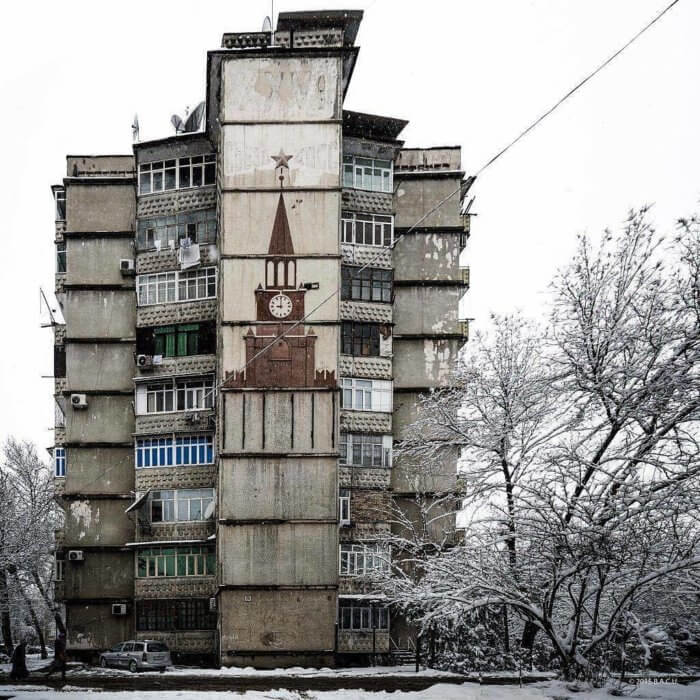
The material produced by this initiative takes two different, still interconnected, forms: their official website and their social media accounts. [4] The website includes more detailed case studies of buildings (with photographs and texts), an interactive map with information about specific buildings (name, location, year of construction, current state, function), pictures taken during field trips, links to the online store where followers can buy books and maps, and other details about the project (Fig. 2).
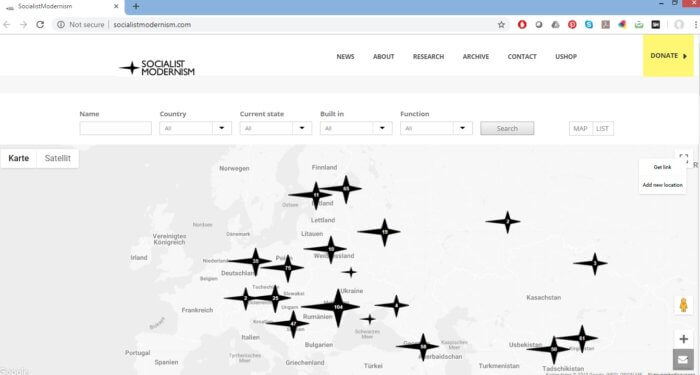
In this paper, I approach critically the infrastructure of distribution provided by the project Socialist Modernism by pointing to the importance of not taking for granted the photographs circulated on their page as reflections of reality. For this, I pay attention to the content of images by following aspects such as point of view, distance, composition, and color. I also analyze the ways in which the public receives these images on social media, for example by looking at how their comments reinforce, expand, or challenge the themes found in the pictures. Finally, by focusing on how visual archival material is shared in a more interactive web-space I reflect on the popularization of socialist architectural heritage and on the wider social and political issues emphasized within the initiative. As I will show throughout my paper, in addition to the information about modernist architecture, this project generates data that is relevant for other directions of research, such as visual analysis, cultural heritage, postsocialism, and urban studies.
In the following, I will look at two examples of visual representation of architecture: the House of Fashion in Minsk, Belarus and the Exhibition Pavilion Cracow (Bunker of Arts) in Krakow, Poland. I will analyze the content and distribution of several photographs and the ways in which the Facebook users respond to these images, through comments, reactions, tagging and sharing. The purpose of this analysis is to highlight some of the questions, relations, and tensions that this type of distribution generates and that could be explored in future research. [6]
At first glance, visitors of the page Socialist Modernism might be tempted to classify the project as an aestheticized perspective on architecture or the product of what Anita Aigner calls the “architectural gaze.” This is to be expected considering the historical relation between architecture and photography within which the “aesthetic eye” has been a precondition for architectural photography. [7]
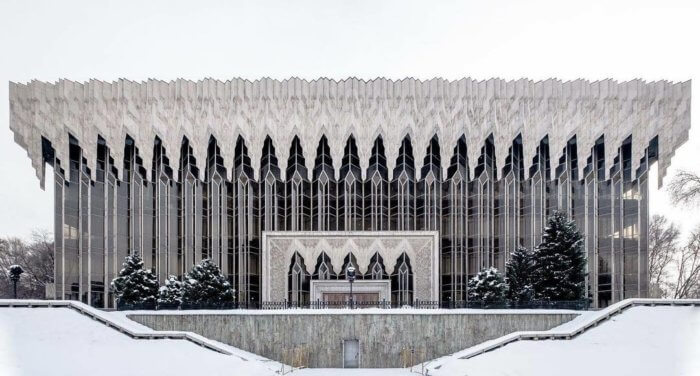
However, on closer inspection, the message conveyed through the images and texts circulated by B.A.C.U. is more complicated. The material distributed is often a mix of aestheticized representations, contextual details, and representations of social problems. This combination is visible not only in the content of the photographs, but also in the comments posted by the social media users. Through their interventions, the viewers acknowledge the architectural value of the building in aesthetic terms while drawing attention to wider social aspects illustrated by the images.
The two cases from Minsk and Krakow discussed in this article illustrate this intersection between architectural photography, focused on the aesthetic appreciation of buildings and socially relevant photography. The visual representations coupled with their distribution on social media underscore specificities of postsocialist change in the urban space, such as practices and values linked to gentrification and consumption.
The first case study is based on photographs showing the House of Fashion in Minsk through wide shots with the building in the center (Fig. 4) and shots taken from one side (Fig. 5), two in black and white and eight in color. [11] Even if the pictures are long shots that include the surroundings instead of zooming in on the details, they still emphasize the bas-relief that takes up a large part of the building and is also referenced in the caption as “Solidarity,” the creation of the sculptor A. Artimovich. However, the photographs also contrast the monochrome bas-relief with the intense colors of the Kentucky Fried Chicken and the pizza restaurants located in the ground floor. In this way, the image shocks the viewer by revealing how the building is taken over by a parasitic structure and it places this example into a wider context of urban change.
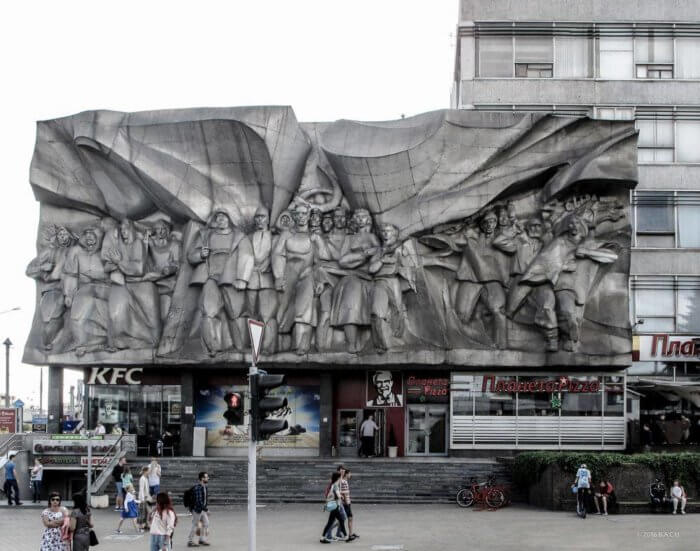
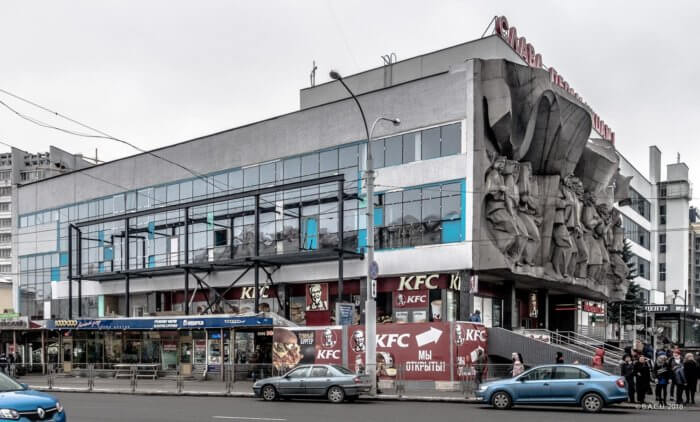
CHF1: Sad to see the impressive and striking House of Fashion has been colonised by the global juggernaut KFC!
CHF2: How sad is it, a sculpture that celebrates the working class and a company that exploits it. [14]
CHF3: [Tag] [15] the irony of a KFC now taking up most of the building is not lost on me
CHF4: [Tag] I’m actually howling.
The House of Fashion case is an example of how the viewers reinforce the ideas conveyed by the content of the images. They are symbolically confronted with the impressive art work attached to the building as well as with the contrast between this material trace of the past and the current alterations and they address these issues directly in their comments.
The second case study includes photographs showing the Exhibition Pavilion Cracow (Bunker of Arts) in Krakow Poland. Two of the photographs are focused on the entrance to the pavilion, taken from the front, with one image showing mostly the concrete walls (Fig. 6) and the other one also showing the windows on top (Fig. 7). A third image captures the same entrance, but from the left side together with a part of the building that is used as a café these days (Fig. 8). Finally, the last picture is taken from a completely different angle, showing another entrance and the café in more detail (Fig. 9). [16]
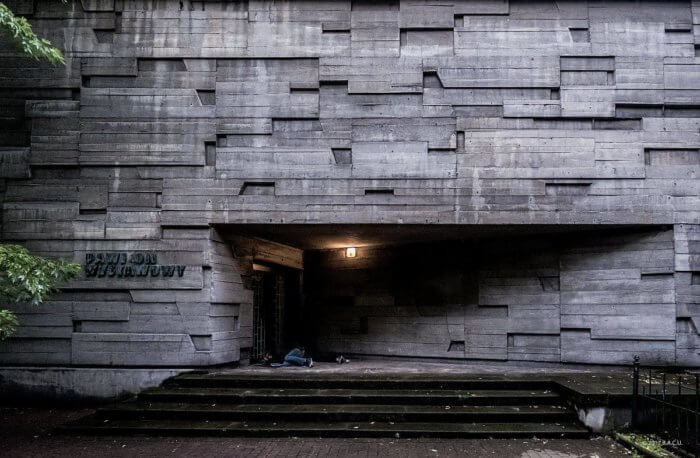
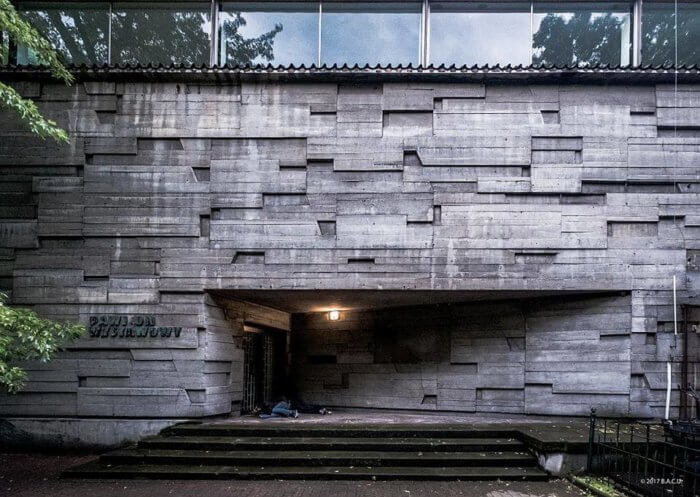
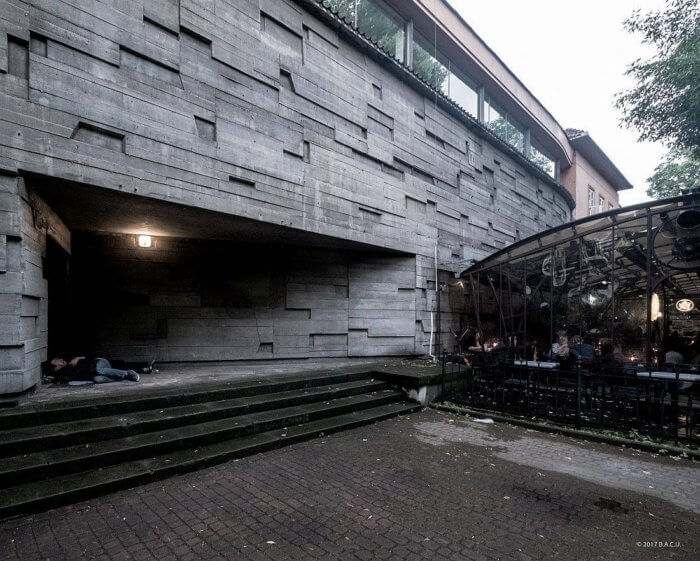
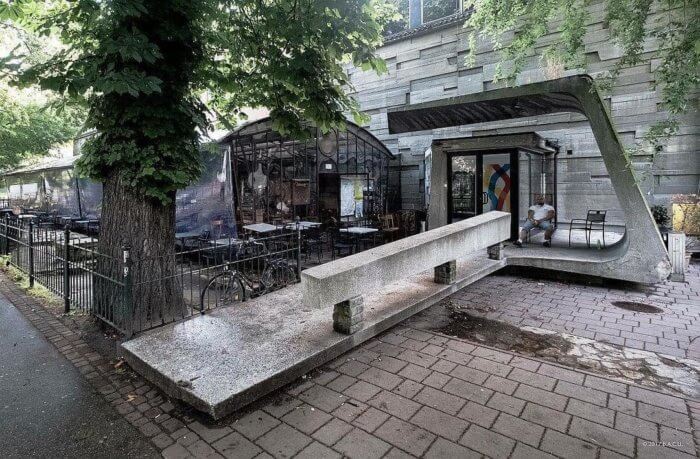
CEPC2: Ironic, few years ago there was a project by Łukasz Surowiec called ‘Poczekalnia/Waiting-room’ – ‘bums’ like this man on picture, homeless people were invited to Bunkier [21] and stayed there for a month. Anyone could help them during this time, share their food or simply just talk. The difference is in your intention.
In addition to exemplifying the contrast between aestheticization and socially relevant images, the case of the Exhibition Pavilion also draws attention to the relation between landscapes and the experience of people, namely the need to look at how the body is involved in matters of emplacement. [22] Future studies could use this material as a starting point for analyzing the experiences of those who occupy certain places, [23] for example by describing a building not so much through its architectural elements, but in reference to “the quality of life that is sustained in it.” [24]
The two cases examined point to the methodological value of Socialist Modernism as a platform that allows a complex approach, combining research in an archive of images and texts with social media analysis focused on how the content is distributed, discussed, and reinterpreted by a wider audience. Namely, it gives insights into how a professional group of architects defines and engages with architectural heritage from socialism as well as how the general public experiences this type of heritage on social media.
The images shared on the Facebook page are accompanied by captions that include information about the name of the building, city and country, year/period of construction, name(s) of the architect(s), and other details. Most of the captions also include a link to the map location and to the official project website where users can upload their own photos (Fig. 10).
The content is also widely shared on other pages and groups managed by B.A.C.U. or on other projects connected with them by a thematic interest. [25] In addition, images are further circulated by the social media users through the share button as well as by tagging users who might be interested in the content in the comments. For example, the pictures showing the House of Fashion building (Fig. 4 and 5) and the Exhibition Pavilion Cracow (Fig. 6, 7, 8, and 9), uploaded on the page Socialist Modernism since 2016, have been shared a total of 343 times and from the 119 comments posted, 35 include a tag of another user. [26]
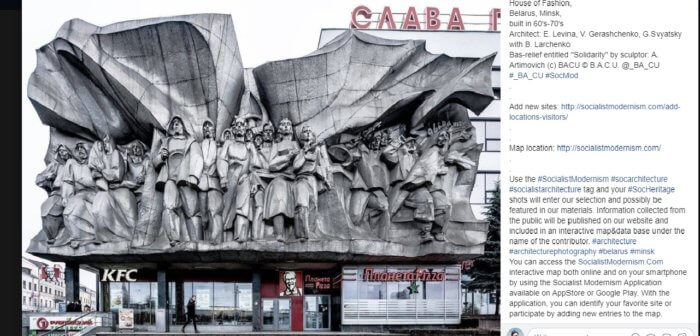
Another salient methodological aspect is the tendency of the social media followers to engage themselves with the pictures circulated by B.A.C.U. in a visual way: by replying with their own photos of the same building or of similar buildings, with screenshots from popular culture, and with the emojis and stickers available on Facebook. From the total of 119 comments posted since 2016, 32 include at least one visual element and twelve of these are photos of the same building taken at a different time and/or from a different angle or photos linked in other ways to the original upload. [30]
Further research on these patterns of visual response can delve into the particularities of a visual approach to digital heritage studies by exploring the aforementioned participatory ways of interacting with heritage in connection to the ways in which images are made meaningful by viewers. [31] For example, an analysis of how the public receives and (re)interprets these images of architecture from the former socialist and Soviet republics can be helpful for understanding how the public contributes to the definition and representation of socialist heritage.
Research focused on architectural heritage in socialism and postsocialism approaches this topic through the notion of a shared socialist past. This is because during socialism architecture was shaped by ideological and economic considerations such as the national projects of industrialization and urbanization, the political promise of mass housing, and the centralized institutional organization of architecture. At the same time, these studies emphasize how universal architectural styles like modernism were reinterpreted in the post-war context of each country depending on local values, relationships, and debates. [32]
The various photographic representations of modernist architecture found on the Socialist Modernism platform underline the commonalities within the former socialist space in terms of architectural practice, types of buildings, and their current endangered state. However, as illustrated by the case studies, the content of the image and the viewers’ responses contribute to a differentiation between countries based on specificities of the landscape, local practices, and personal experiences.
In this article, I engaged with the digital infrastructure provided by the project Socialist Modernism by describing the type of visual and textual data it provides access to and the unconventional research site it creates on social media, where the general public interacts with this content. However, this is not a mechanical process of distribution and knowledge production in the digital realm. The way in which this type of architectural photography is circulated and received on social media contributes to the definition, representation, and experience of digital heritage in the context of socialist and postsocialist built environment and architectural practice.
_How to Cite
Maria Cristache. “Modernist Architecture and Visual Culture: Online Forms of Distribution.” On_Culture: The Open Journal for the Study of Culture 8 (2019).

_Endnotes
- [1] © BACU photo department/2015.
- [2] “Socialist Modernism: About,” B.A.C.U., accessed September 2, 2019, <http://socialistmodernism.com/about/>; “B.A.C.U.: About,” B.A.C.U., accessed September 2, 2019, <http://bacu.ro/despre/>.
- [3] So far, they managed to include the Chisinau State Circus building on the Historical Monuments Register in Moldova. “Heritage Listing Announcement,” B.A.C.U., accessed September 2, 2019, <http://socialistmodernism.com/heritage-listing-announcement/>.
- [4] The project has Facebook, Twitter, Instagram and Tumblr accounts. For the purpose of this paper, I will focus on the content distributed on Facebook because the project has a longer history there, more intense activity and it allows me to search more thoroughly through the visual material.
- [5] Screenshot from the website of the project Socialist Modernism © BACU/2019.
- [6] This paper is part of a larger ongoing project focused on the digitization of architectural heritage from socialism. Given then initial stage of this project, the observations discussed here are not based on an exhaustive classification of the images and comments posted on the Facebook page of Socialist Modernism. This is an exploratory analysis of 14 pictures (ten showing the House of Fashion and four the Exhibition Pavilion) and 119 comments (100 and 19 respectively) posted on Facebook between August 2016 and September 2019.
- [7] Anita Aigner, “Heritage-Making ‘from below’: The Politics of Exhibiting Architectural Heritage on the Internet — a Case Study,” in International Journal of Heritage Studies (2015), 1–19, here: 10, DOI: 10.1080/13527258.2015.1107615.
- [8] © BACU photo department/2019.
- [9] Aigner, “Heritage-Making ‘from below,’” 10.
- [10] Aigner, “Heritage-Making ‘from below,’” 10; Pierluigi Serraino, “Framing Icons: Two Girls, Two Audiences. The Photographing of Case Study House #22,” in This Is Not Architecture: Media Constructions, ed. Kester Rattenbury (London/New York: Routledge, 2002), 127–136.
- [11] These photographs can be found on the Facebook page of Socialist Modernism: <https://www.facebook.com/SocModernism/>.
- [12] © BACU photo department/2016.
- [13] © BACU photo department/2018.
- [14] Socialist Modernism is a public Facebook page, meaning that the images and comments posted there can be seen by anyone with a Facebook account. The content is much more visible there than in the case of personal accounts, closed and secret groups where one needs the approval of administrators to join and see the content. However, in order to protect the anonymity of the users whose comments I analyzed in this paper, I replaced their names with codes and did not include links to the specific pictures where these comments can be found. All the comments are posted on the official page of Socialist Modernism: <https://www.facebook.com/SocModernism/>.
- [15] In the following comments I have removed the names of the tagged users in order to ensure their anonymity.
- [16] These photographs can be found on the Facebook page of Socialist Modernism: <https://www.facebook.com/SocModernism/>.
- [17] © BACU photo department/2017.
- [18] © BACU photo department/2017.
- [19] © BACU photo department/2017.
- [20] © BACU photo department/2017.
- [21] Polish translation of “bunker”.
- [22] Edward S. Casey, “How to Get from Space to Place in a Fairly Short Stretch of Time: Phenomenological Prolegomena,” in Senses of Place 27 (1996), 14–51, here: 21.
- [23] Casey, “How to Get from Space to Place,” 16.
- [24] Casey, “How to Get from Space to Place,” 27.
- [25] Pages: B.A.C.U. official page, SocHeritage, SocMonumental Art. Groups: Defense Architecture, The Brutalist Appreciation Society, Brutal Tours&Friends, Utilitarian Architecture, _BRUT.
- [26] Out of the ten pictures of the House of Fashion building, I included only two in this article because there were several duplicates on the Facebook page of Socialist Modernism (the same picture posted several times or the same picture both in color and black and white). However, my analysis is based on the comments and reactions to the whole set of ten photographs. In the case of the Exhibition Pavilion, all the pictures analyzed are included in the article as well.
- [27] © BACU/2019.
- [28] Elisa Giaccardi, “Introduction: Reframing Heritage in a Participatory Culture,” in Heritage and Social Media, ed. Elisa Giaccardi (London/New York: Routledge, 2012), 1–10.
- [29] Giaccardi, Introduction, 6.
- [30] For example by showing similar buildings or details of the building shown in the original upload.
- [31] Sarah Pink, “Interdisciplinary Agendas in Visual Research: Re-Situating Visual Anthropology,” in Visual Studies 18.2 (2003), 179–192, here: 186, DOI: 10.1080/14725860310001632029.
- [32] Marija Drėmaitė, Baltic Modernism: Architecture and Housing in Soviet Lithuania (Berlin: DOM publishers, 2017), 9–18, here: 313; Virág Molnár, “Cultural Politics and Modernist Architecture: The Tulip Debate in Postwar Hungary,” in American Sociological Review 70 (2005), 111–135, here: 116, 130.


